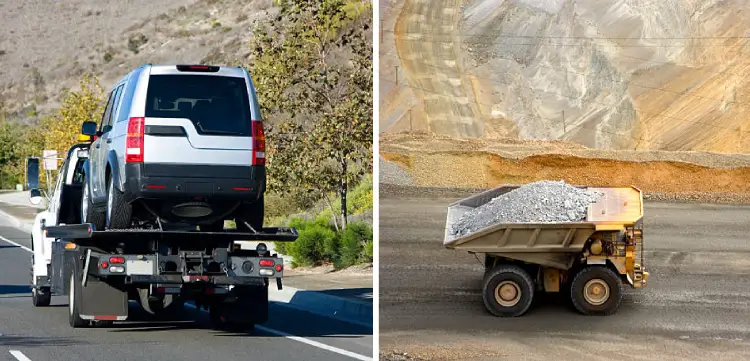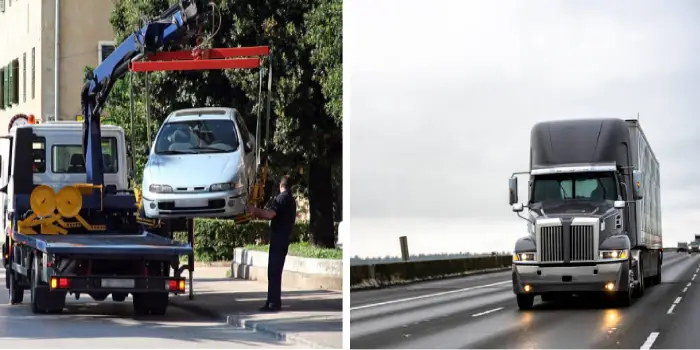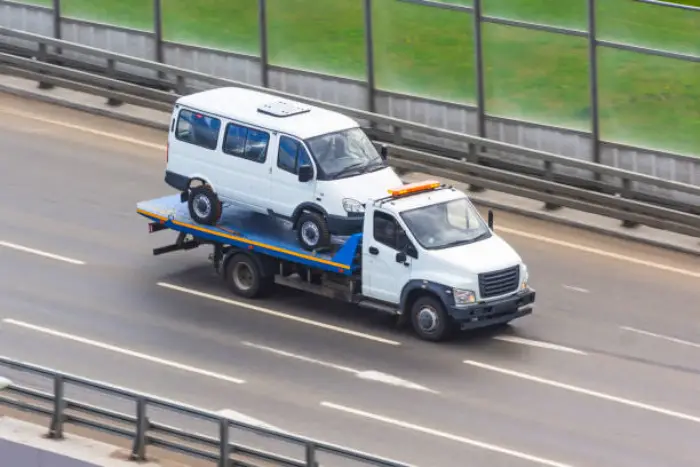
You’re not alone if you’ve ever been confused about the difference between towing and hauling. These terms are often used interchangeably, but they actually refer to two distinct activities with their own unique characteristics.
Understanding the difference in towing and hauling is crucial, especially if you’re involved in industries such as transportation or logistics.
Towing refers to towing a vehicle or object in the rear of another vehicle using a hitch or tow bar. It typically involves connecting one vehicle to another and requires a specific type of equipment designed for this purpose.
Conversely, hauling refers to transporting goods or materials in a container or trailer attached to a truck or other heavy-duty vehicle. Hauling usually involves loading and securing items in the container, ensuring their safe transportation.
Here, we’ll look at the differences between these two activities. Let’s get started.
The Compare and Contrast of Towing and Hauling

With regard to the distinction of towing and hauling, there are several key points to consider. Most of them are given below:
- Section 1: Definition and Equipment
- Section 2: Purpose
- Section 3: Cost-effectiveness
- Section 4: Types of Vehicles and Objects
- Section 5: Distance
- Section 6: Protection of Vehicles and Objects
- Section 7: Insurance
- Section 8: Permits and Documentation
- Section 9: Customer Niche
Section 1: Definition and Equipment
Amidst the bustling city streets, tow trucks equipped with flatbed trailers, winches, hydraulics, and dollies stand ready to transport broken-down vehicles to safety. Towing involves pulling a vehicle behind another using these specialized equipment.
In contrast, hauling refers to carrying heavy loads on a truck or trailer. Hauling trucks are designed with greater carrying capacities than their size, allowing them to transport large and heavy items efficiently.
Section 2: Purpose
If you want to get your broken-down vehicle to safety or transport large, heavy items efficiently, you need to understand the purpose of towing and hauling.
Towing is used to transport non-operational vehicles for short distances while hauling is meant for moving bulky and heavy vehicles over long distances. The main goal of towing is to quickly transport a disabled vehicle while hauling focuses on safely transporting oversized loads over extended periods.
Companies like commercial towing Santa Clara provide their customers with different towing and hauling services. Their purpose is also to assist others with roadside assistance like car battery replacement, car lockout and tire change services.
Section 3: Cost-effectiveness
Regarding cost-effectiveness, towing is generally more affordable than hauling for short distances. Towing trucks are typically smaller and have lower carrying capacities than haul trucks, resulting in lower fuel consumption and operating costs.
Then again, hauling is more cost-effective for long-distance transportation of vehicles. Hauling companies charge based on distance, making it a more cost-effective option for customers transporting their vehicles over a long distance.
Section 4: Types of Vehicles and Objects
Towing is more commonly used for smaller vehicles such as cars, motorcycles, and boats. Tow trucks are equipped with specialized equipment such as dollies, flatbed trailers, winches, and hydraulics to help transport these smaller vehicles.
Alternatively, hauling is ideal for transporting larger and bulkier objects such as various automobiles, boats, motorcycles, and shipping containers over long distances. Hauling trucks have a higher carrying capacity than their size and are equipped with specialized trailers to carry these bulky objects.
Section 5: Distance
As far as transporting vehicles and objects, distance plays a crucial role in determining the most suitable method. To transport items over a short distance, towing is your best option. It involves attaching the vehicle or object to another vehicle with a tow bar or trailer.
Thus, hauling is ideal if you need to transport something over a long distance. This involves loading the vehicle or object onto a truck or trailer for transportation.
Section 6: Protection of Vehicles and Objects
For long-distance transportation, hauling transport provides greater protection for vehicles and objects, ensuring they arrive in top condition.
When towing a vehicle, there is a risk of wear and tear due to the direct contact between the towed vehicle and the road surface. This can lead to damage such as scratches, dents, or even tire blowouts.
In contrast, hauling uses specialized carriers that securely hold vehicles in place, protecting them from potential road hazards and minimizing the risk of damage during transit.
Section 7: Insurance
In terms of insurance, both towing and hauling companies require proper coverage to protect themselves and their customers in case of unforeseen accidents or damages.
Towing companies may opt for coverage options such as physical damage, garage liability, and wrongful repo. These types of coverage protect the towing company from any damage that may be caused to the customer’s vehicle during the towing process and any other unforeseen circumstances that may arise.
Meanwhile, auto haulers are required to have adequate insurance coverage by the Federal Motor Carrier Safety Administration (FMCSA). This coverage provides protection for the items being transported, as well as the hauler.
Auto hauler insurance typically covers property damage, bodily injury, cargo damage, and liability, ensuring full protection for both the customer and the service provider.
Section 8: Permits and Documentation
Regarding hauling, certain types of vehicles or special items may require additional permits or documentation.
However, in the case of towing, no extra permits or documentation are needed. This makes towing a more straightforward process in terms of regulatory requirements.
Always ensure that you have the necessary permits and documentation to avoid any legal complications while conducting your business.
Section 9: Customer Niche
Depending on the type of towing, customers can vary from those with flat tires, overheating vehicles, or involved in accidents.
Conversely, hauling services cater to a different customer niche. Classic car collectors, people relocating with multiple vehicles, and online car dealers are just a few examples of customers who require hauling services for their specific needs.
Towing or Hauling: Safe and Efficient Transportation

So now you know the difference between pulling and hauling.
Towing refers to the act of pulling or dragging a vehicle with a tow bar, rope, or chain behind another vehicle. In contrast, hauling involves moving goods or materials using a truck or trailer.
Both activities require different equipment and have their own set of rules and regulations.
Whether you need to tow a broken-down car or haul heavy construction equipment, understanding these differences will help you make informed decisions about moving objects from one place to another.
